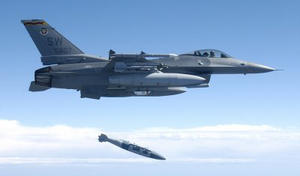IranCountdown begins to attack on Iran
On Tuesday in Moscow, the third round of talks between the P5+1 (the five permanent members of the Security Council plus Germany) and Iran over Iran’s nuclear program ended with the gap between the two sides as wide as ever; there are no plans for more meetings; this means that on 1 July, a new, crippling round of sanctions will be imposed on Iran; the previous round of sanctions de-linked Iranian banks and companies from the international banking system; the coming round of sanctions – which includes, among other things, the removal of insurance from tankers carrying Iranian oil – will bring an end to nearly all of Iran’s oil sales, sales which account for nearly 80 percent of Iran foreign revenues; planning, in both Israel and the United States, for an attack on Iran’s nuclear facilities has now shifted to a higher gear; Congress holds hearings on Israel’s Iran-specific military equipment needs

An F-16 releasing a GBU-31 "bunker-buster" // Source: booof.ir
On Tuesday in Moscow, the third round of talks between the P5+1 (the five permanent members of the Security Council plus Germany) and Iran over Iran’s nuclear program proved as fruitless as the previous two rounds, held in Ankara and Baghdad. The two sides agreed that the gap between them is just too wide.
There is no mystery why the gap is so wide. Iran wants to continue to augment the capabilities which will allow it to build nuclear weapons, while the goal of the P+5 is to prevent Iran from augmenting these capabilities.
These are differences which may be papered over, but they cannot be bridged.
The impasse
Iran makes two claims. The first is that under the terms of the Nuclear Nonproliferation Treaty (NPT), of which it is a member, it has a right to enrich uranium. The second claim is that its uranium enrichment program is for peaceful purposes. The two claims are easily refuted.
The NPT does allow member states to enrich uranium – but only if the enrichment activities are subject to strict and intrusive monitoring by inspectors of the International Atomic Energy Agency (IAEA) to verify that the enriched uranium is for peaceful purposes: energy generation, medical treatment, research, etc.
The policy of Iran is to prevent meaningful IAEA inspection of the country’s nuclear facilities. Iran has employed different tactics to prevent the IAEA inspectors from doing their jobs: it “declared” (this is the language of the treaty) some of its nuclear facilities – and opened some of them to inspection, but prevented inspectors’ access to other declared facilities; it has concealed (that is, it did not declare, as is its obligation under the NPT) the very existence of other nuclear facilities from the IAEA, thus giving itself the ability to run a hidden nuclear weapons program in parallel to its declared nuclear activity; it submitted forged documents, false evidence, and incomplete narratives to inspectors, and coached its scientists to lie in interviews with IAEA inspectors (those scientists, that is, who are allowed to meet with the inspectors).
Here is the latest example of Iran’s approach to its duties as a member of the NPT: Over the last two years Iran has conducted a series nuclear warhead-related tests at a military base in Parchin, aiming to master one of the more delicate, and demanding, aspects of nuclear weapons design: the timing sequence of nuclear warhead triggering mechanism. The tests have now been completed, and satellite images show that in the last three weeks, the Iranian military has been using many pieces of heavy equipment to destroy buildings and labs at the site and haul away debris, soil, and equipment.
The reason: in a few weeks the base will be sanitized, with all evidence of nuclear weapons-related activity removed. Iran would then make a big deal of letting IAEA inspectors into Parchin – something the agency has been requesting for a while now. The inspectors will find nothing, and Iran will be able to portray itself as a) complying with IAEA requests for inspection of its nuclear facilities, and b) doing nothing of an illicit nature on the nuclear front. Iran will probably also demand the removal of some of the sanctions imposed on it in return for the Parchin concession.
It should also be noted that the NPT and the IAEA are both part of the UN system. One of the conditions to membership in the UN is the acceptance of all other member states. Iran violates this condition of UN membership by having an official policy calling for wiping Israel, a fellow UN member, off the face of the earth.
Legal scholars argue that Iran cannot claim to have the rights of a member of the UN system while, at the same time, rejecting the conditions and obligations that come with UN membership.
Iran’s claim that its enrichment activities are for peaceful purposes are also contradicted by the facts. For use in commercial light water reactors (LWR), the most prevalent power reactors in the world, uranium is enriched to 3 percent to 5 percent. Fresh low-enriched uranium (LEU) used in research reactors is usually enriched 12 percent to 19.75 percent. Uranium enriched to more than 20 percent is used for the production of medical isotopes, for example molybdenum-99 for technetium-99m generators.
The fissile uranium in nuclear weapons usually contains 85 percent or higher of U-235, but uranium enriched to between 20 percent and 85 percent can also be used for crude nuclear weapons.
Iran has already enriched 6,300 kg of uranium to 3.5 percent, and more than 150 kg of uranium to 20 percent. It also has more than 10,000 operational centrifuges, enriching eight kilograms of uranium a day.
